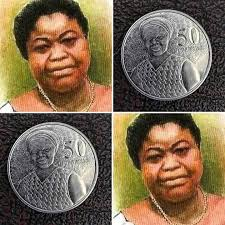
How the Woman on the 50 Pesewa Coin, Known as "Ashikishan," Was Killed
Were you aware of the death of Rebecca Naa Dedei Aryeetey, better known as Dedei Ashikishan? This post will tell you how she passed away.
Dedei Ashikishan was a businesswoman, feminist, and political activist from Ghana. She was well-known in Accra for operating a flour company. The woman depicted on Ghana's 50 Pesewas currency is also her. She was also given the name Auntie Dedei after the Ghanaian two-decker bus.
Born in 1923, Rebecca Naa Dedei Aryeetey passed away on June 22, 1961.
How the Ashikishan Was Slain
Her affinity for Nkrumah turned her into a competing political party's opponent, which is said to have contributed to her untimely death. At the age of 38, she passed away tragically on June 22, 1961, during a CPP function in Ho. When the feminist and political activist complained of a stomach ache at the event, it was claimed that she had been poisoned after drinking hot tea.
CAREER
Rebecca Naa Dedei Aryeetey was the chief financier and political activist of the CPP, which Kwame Nkrumah commanded.
To be featured on a national currency requires a lot of hard work and accomplishments, especially for a woman in a world where men predominate.
Although many people have seen the picture on the 50 pesewas coin, many are unaware of how she was chosen to be there.
Very little information on women leading and assisting the fight for independence and self-rule has been included in historical accounts of events in Ghana.
Yaa Asantewaa is one of the few, if not the only, women who has been favored in Ghanaian history. You may have heard of the 50 pesewas coin by now, as well as the double-decker buses that have recently gained notoriety as the Auntie Dedei buses. But who is this woman, and why does she deserve to be featured even on national currency?
How Ashikishan Was Killed
She is said to have been raised in the hearts of the capital of Ghana, a place known as James Town and went into flour business right after basic school.
At the age of 30, she had become popular for her exploits in the flour business and had won for herself the title ‘Flour Queen’ leading the Market Women Association.
As campaigner and financier of the CPP, she campaigned and funded Kwame Nkrumah’s first political campaign which saw him win the Ashiedu Keteke seat in the house of legislature, a place that was said to be the nerve centre of the Ga-Dangme Confederacy.
Many political historians have alluded to the fact that If Mr Nkrumah had lost that seat, he would never have become the Prime Minister of Ghana.
By the time Mr Nkrumah was released from jail in 1951, Gbedemah had mobilised the market women as the backbone of CPP in Accra. The leader of the pack was Naa Dedei.
CONTRIBUTIONS
Naa Dedei heavily contributed financially to support the CPP. She increased her influence through her contributions day in day out.
She became a target of other political parties and the colonial government following her closeness with Mr Nkrumah. Historical accounts say she had accompanied Mr Nkrumah to a CPP party function in Ho. She was served food and complained later of stomach pains.
She was suspected to have suffered food poisoning and died. She died single and childless. She has been described by many history writers as a true nationalist who campaigned and funded Mr Nkrumah against her own kinsman Odarkwei Obetsebi-Lamptey.
The fact that many do not know about her contribution to Ghana’s independence could perhaps be the reason she is not celebrated enough as a contributor to Ghana’s Independence.
On 1st July 2007, the Cedi (₲) was redenominated to the GH (¢), such that ₲10,000.00 was equivalent GH¢ 1.00. The redenomination did not affect the intrinsic value of the currency.
The Central Bank gave two reasons for the redenomination. Thus, increasing difficulty in maintaining accounting and statistical records and problems with accounting data and processing software.
By this development, a new 50 pesewas coin came into circulation with Rebecca Naa Dedei Aryeetey becoming the face on the popular coin.
